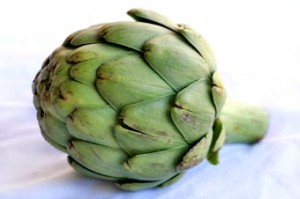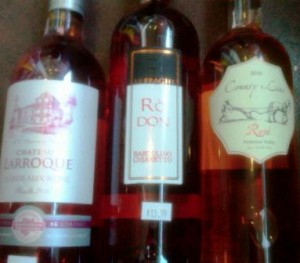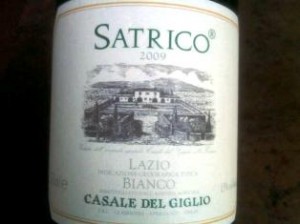For some people it’s all about getting through the holidays. Others embrace the season with aplomb. For wine lovers, it doesn’t matter which camp you fall into! Wine served is a life lived well. One of our clients couldn’t have agreed more, inviting us to consult on some holiday wine selections for them. The line-up was so worthy, we thought we would impart a little Christmas cheer by sharing with you, too! And so we bring to you Pour Favor’s 12 Wines of Christmas. Consider the holidays saved!
On the first day of Christmas my true love gave to me gentle rosé bubbles! Domaine Robert Serol’s “Turbullent” vin rose festif et petillant is as festive, lively and lovely as it sounds, featuring 100% Gamay. It’s earthy yet bright, red-fruited nature combined with just a touch of effervescence is the perfect thing to get you in the holiday spirit. Pop cork, trim tree!
On the second day of Christmas my true love gave to me single vineyard Carmenere and gentle rosé bubbles! Oveja Negra’s Maule Valley single vineyard Carmenere is one of our favorite single-varietal wines of the year. Robust and pure, this dark, smooth and brooding yet lifted wine is buoyed by Chilean earth and finishes with a dark chocolate espresso note. Sip and savor with the homemade fudge your neighbor dropped by – and relish looking at your trimmed tree.
On the third day of Christmas my true love gave to me Cali Grignolino(?!), single vineyard Carmenere and gentle rosé bubbles! ‘Tis always the season to embrace the wierdos, and Heitz Cellar’s Napa Grignolino is certainly that - until we saw/tasted this wine we didn’t know they were even cultivating this grape in California, one traditionally grown (in limited quantities) in Piedmont, Italy. After last night’s fudge fest, you’ll relish this charming, lighter-bodied, silky, slightly fertile wine with baking spices on the finish. Put out the bowl of imported strawberries and dive in!
On the fourth day of Christmas my true love gave to me Muri-Gries Mueller-Thurgau, Cali Grignolino(?!), single vineyard Carmenere and gentle rosé bubbles! A Riesling and Sylvaner hybrid grape, Mueller Thurgau is a gift in and of itself as opulent freshness is buoyed by all the main apple varieties - red, yellow and even tart green – and a thrilling herbal component comes into play. Tough day wrapping up projects at work before the end of the year? No worries! This killer white will tickle your tinsel-time fancy!
On the fifth day of Christmas my true love gave to me Montecucco Sangiovese, Muri-Gries Mueller-Thurgau, Cali Grignolino(?!), single vineyard Carmenere and gentle rosé bubbles! With just one week ‘til Santa is nigh you’ll need something with power and elegance to give you a mental timeout while you start wrapping presents. Sink your teeth into Campi Nuovi’s Montecucc Sangiovese and call it done! This unfiltered, organic certified wine is Old World bliss: blackberry and cherry tang are composed by worn leather and fresh earth. You’ll be mid-bow-tying and having a ‘damn! That’s good’ moment. Promise.
On the sixth day of Christmas my true love gave to me awesome Austrian Pinot Noir, Montecucco Sangiovese, Muri-Gries Mueller-Thurgau, Cali Grignolino(?!), single vineyard Carmenere and gentle rosé bubbles! After all that wrapping you’re thinking how much you’ve spent this month and wondering how you’re going to keep drinking well without breaking the bank. Enter Johanneshof Reinisch Pinot Noir. We’ll let this one speak for itself. It’s that good!
On the seventh day of Christmas my true love gave to me limited Napa Cab Franc, awesome Austrian Pinot Noir, Montecucco Sangiovese, Muri-Gries Mueller-Thurgau, Cali Grignolino(?!), single vineyard Carmenere and gentle rosé bubbles! Tonight you’re ordering pizza and uncorking a really special bottle to enjoy all on your own (partner optional). You’re so excited about it you even have the presence of mind to uncork before you head out the door to work. And why wouldn’t you be? Only 3 barrels of Hendry Blocks 9D & 26 Napa Cabernet Franc were made – and your true love was lucky enough to score one and smart enough to squirrel it away for you. Tonight Christmas comes early!
On the eighth day of Christmas my true love gave to me the best rosé in the world, limited Napa Cab Franc, awesome Austrian Pinot Noir, Montecucco Sangiovese, Muri-Gries Mueller-Thurgau, Cali Grignolino(?!), single vineyard Carmenere and gentle rosé bubbles! Tavel from the Rhone could rival Provence for historic rosé recognition. Here we are talking about wines that are outstanding when fresh, and mesmerizing when they have a little bit of age on them. Chateau d'Aqueria hits the genre out of the vineyard with a generous, winter-ready body, mineral-rich purity, lovely flowers (violets and roses alike) and a light spice note. Get out your charcuterie board and call it a casual night in while the family comes over the river and the through the woods to your house.
On the ninth day of Christmas my true love gave to me Bordeaux, the best rosé in the world, limited Napa Cab Franc, awesome Austrian Pinot Noir, Montecucco Sangiovese, Muri-Gries Mueller-Thurgau, Cali Grignolino(?!), single vineyard Carmenere and gentle rosé bubbles! It’s now Sunday night and you’ve been cultivating your beef stew in the slow-cooker all day while you were out doing last minute stocking-stuffer shopping. Fortunately you’re true love knew a good Bordeaux would be the perfect match! Chateau Bourbon la Chapelle offers all of the flinty magic of the Médoc, with graphite and tea adding interest to an otherwise pretty, black-fruited wine that’s not weighed down by wood-aging. Could Santa be your true love?!
On the tenth day of Christmas my true love gave to me a crazy Spanish red, Bordeaux, the best rosé in the world, limited Napa Cab Franc, awesome Austrian Pinot Noir, Montecucco Sangiovese, Muri-Gries Mueller-Thurgau, Cali Grignolino(?!), single vineyard Carmenere and gentle rosé bubbles! We all know Santa makes it to all ends of the earth on his sled, so it’s only natural to channel his exploration sensibilities this time of year. Anima Negra’s AN2 is mesmerizing, kind of like Rudolph’s nose. Hailing from Majorca, Spain, you don't see these too often, either! A blend of Callet, Mantonegre-Fogoneu and Syrah grapes it opens with floral aromas, and graces the palate with ripe, round red raspberry fruit flavors. It is refreshing yet firm, soft but juicy. It says, “Snuggle up to that roaring fire with me in your glass!”
On the eleventh day of Christmas my true love gave to me White Burgundy, a crazy Spanish red, Bordeaux, the best rosé in the world, limited Napa Cab Franc, awesome Austrian Pinot Noir, Montecucco Sangiovese, Muri-Gries Mueller-Thurgau, Cali Grignolino(?!), single vineyard Carmenere and gentle rosé bubbles! For us seeing the Sugar Plum Fairy’s solo is a highlight to beheld this time of year – her grace, elegance and memorable strength and presence can’t be beat. The wine equivalent of this experience is Domaine Bachelet-Monnot’s Bourgogne blanc. Christmas Eve you’ll want to bring out something this magical. Uncork and hear the bells!
On the twelth day of Christmas my true love gave to me sexy Nebbiolo, White Burgundy, a crazy Spanish red, Bordeaux, the best rosé in the world, limited Napa Cab Franc, awesome Austrian Pinot Noir, Montecucco Sangiovese, Muri-Gries Mueller-Thurgau, Cali Grignolino(?!), single vineyard Carmenere and gentle rosé bubbles! Christmas can’t come without Nebbiolo being in the mix. And while many gravitate first (among the elite Piedmontese styles) to Barolo, our heart is aflutter with the more feminine Barbaresco. Ca’ del Baio’s revered cru “Asili” vineyard Barbaresco is one of our favorites in particular, offering pedigree (fine tannins and varietal zip) and panache as mulled cherry notes meet herbal lift in a generous and open package. Merriment indeed!
And with that, we wish you Happy Holidays from all of us at Pour Favor!









 It's summer in the city and yet I am drinking just about equal parts red, white and rose. What gives? The temperature - of my red wines, that is!
Talking to people every day about wine I know there is a misconception out there that red wine shouldn't go in the fridge. Believe me when I tell you that's far from the truth. Personally speaking, I've found the notion is reinforced when you go out to eat. More often than not if you go to a nice restaurant they are missing the mark with the temperature they serve their wines; it is a challenge for them to keep their glass pours cold enough because they are often refilling glasses or uncorking new bottles and the wine either never goes back into the wine fridge due to the turnover, or it comes from too warm a place on the shelf behind the bar where it is easily accessible.
It's summer in the city and yet I am drinking just about equal parts red, white and rose. What gives? The temperature - of my red wines, that is!
Talking to people every day about wine I know there is a misconception out there that red wine shouldn't go in the fridge. Believe me when I tell you that's far from the truth. Personally speaking, I've found the notion is reinforced when you go out to eat. More often than not if you go to a nice restaurant they are missing the mark with the temperature they serve their wines; it is a challenge for them to keep their glass pours cold enough because they are often refilling glasses or uncorking new bottles and the wine either never goes back into the wine fridge due to the turnover, or it comes from too warm a place on the shelf behind the bar where it is easily accessible.


